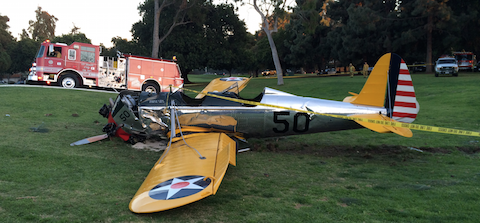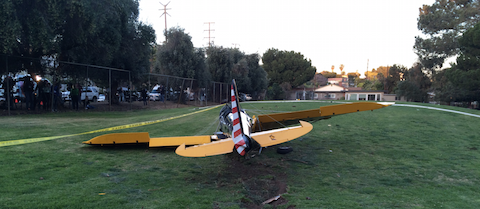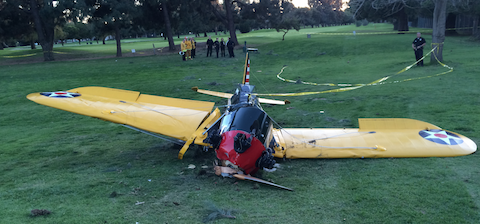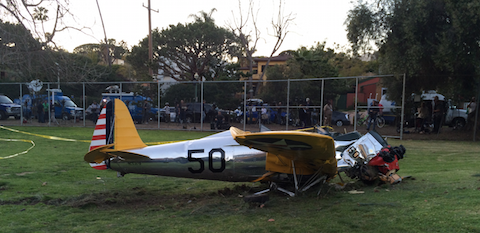Plane crashes involving actor Harrison Ford
Actor Harrison Ford, who played either a pilot or a former pilot in films such as "Air Force One," "Star Wars," and "Six Days, Seven Nights" is a real life pilot who has survived at least three accidents.
13 February 2017 - Santa Ana, California
A single-engine Aviat Husky aircraft (N89HU) flown by Harrison Ford was cleared to land on runway 20L at John Wayne/Orange County Airport in Santa Ana, CA.
Ford's aircraft reportedly landed on a parallel taxiway, overflying American Airlines 737 (flight 1546) that was holding short of runway 20L.
The FAA completed an investigation and took no administrative or enforcement actions against Ford.
Daily Mail article on the incident
Video of Harrison Ford landing incident
Harrison Ford landing incident ATC exchange
5 March 2015 - Santa Monica, California
Ford was the pilot and sole occupant of a Ryan ST3KR Recruit, a two-seat, open cockpit aircraft that was used extensively as a training aircraft by the US military in WWII.
According to a preliminary report from the NTSB, Ford reported a loss of engine power shortly after taking off from the Santa Monica airport, and was attempting to return to runway 3 at Santa Monica.
Ford chose to land on a nearby golf course, clipping the top of a tree before landing. The aircraft was seriously damaged, and Ford was hospitalized with serious injuries.
The aircraft, which had the registration number N53178, was manufactured in 1942, coincidentally the same year as Harrison Ford's birth, and according to the FAA, the plane was certified to fly until 31 October 2015.
Summary of factual report
The NTSB factual report on the Harrison Ford crash in Santa Monica was released on 28 July 2015, and was noteworthy in the level of detail that was included in the report given that:
- The accident involved a private aircraft with a single occupant,
- There were no fatalities or serious injuries other than to the pilot,
- The event occurred near an airport with no significant airline operations, and
- The only significant injuries or were to the pilot, and the only significant damage was to the aircraft.
The following highlights and insights about Harrison Ford and about the crash were taken from the factual report and from the public docket associated with this crash, which included a post-crash NTSB interview with Harrison Ford and several witnesses:
- Harrison Ford, age 72, had about 5,000 hours of flight experience, of which about 3,000 was as pilot in command.
- He was rated for Multi-engine Land; Single-engine Land; Single-engine Sea, and Helicopter.
- He had a type rating for the Citation models C680 and C525 jets.
- He had about 1,500 hours in multiengine aircraft, and 500 in rotorcraft.
- He had about 75 total hours of experience in the make and model of the accident aircraft.
- Ford had flown the aircraft about one week earlier.
- In the 30 days prior to the accident, he had 17.7 total hours, with 7.6 of those hours in single engine aircraft, including three hours that were in the same make and model as the accident aircraft.
- The toxicology tests performed by the FAA's Civil Aerospace Medical Institute (CAMI) showed the presence of morphine and ondansetron in Ford's system, and also found that these toxicology results were consistent with the medications administered during his medical treatment.
- Ford was on a local VFR flight, planned to fly only in the airport traffic pattern for about 20 minutes, and did not file a flight plan.
- Restoration of the airplane and engine overhaul was completed on May 21, 1998.
- At the time of the accident, the airframe and engine had accumulated approximately 169 hours in the 17 years since the restoration.
- About one minute after takeoff, Ford reported a loss of power.
- He later stated that he was in a left turn (about 15 degrees of bank) at about 1100 feet above sea level.
- He did not attempt an engine restart, and maintained an airspeed of about 85 knots as he attempted to return to the airport.
- After he made a left turn towards the airport, he had no memory of anything until he woke up in the hospital.
- About two minutes elapsed between the time Ford was cleared for takeoff until his last radio transmission.
- The airplane struck the top of a tree that was about 65 ft tall, and then impacted the ground in an open area of a golf course.
- There was a post-crash fuel leak, but no evidence of smoke or fire.
- The airplane came to rest about 150 feet from the tree, and there were about 25 feet of ground scars, implying that there was about a 27.5 degree angle from the top of the tree to the first point of impact.
- The aircraft came to rest at a magnetic heading of 44 degrees, and winds were from 220 degrees at 10 knots, making it very likely that the aircraft was experiencing a tailwind at the time of the crash.
Summary of the probable cause report
The NTSB probable cause report on the Harrison Ford crash in Santa Monica was released on 6 August 2015, and stated that the carburetor's main metering jet was unscrewed from its seat and rotated 90 degrees.
The unseated and rotated jet would have allowed an increased fuel flow through the main metering orifice, producing an extremely high ratio of fuel to air, which would have resulted in the loss of engine power.
The report also stated that an improperly installed shoulder harness likely contributed to the severity of the pilot's injuries.
Additional information about this accident
ATC audio from the crash
6 March Newsmax interview about the investigation
8 March CJOB radio interview about the investigation
NTSB factual report (Accident number WPR15FA121)
NTSB post-accident interview with Harrison Ford and other witnesses
18 June 2000 - Lincoln, Nebraska
While landing in Lincoln, NE, Ford's plane departed the runway due to a gust of wind. The aircraft, a Beechcraft Bonanza, sustained minor damage, and neither Ford or his passenger were injured.
23 October 1999 - Santa Clarita, California
Ford was on a training flight in a Bell 206 helicopter when he and the instructor made an emergency landing in a dry riverbed near Santa Clarita, CA.
Although the helicopter rolled over on its left side, neither Ford or the instructor were injured. The following description is based in part on the NTSB factual report of the event, as well as the NTSB accident brief.
At 1115 hours Pacific Daylight Time, a Bell 206-L4, registration number N36R, landed hard and rolled over in the Lake Piru riverbed near Santa Clarita, California. The helicopter, operated by AG Aviation, Teterboro, New Jersey, was substantially damaged. The pilot (Ford) was practicing autorotations to a power-on recovery. When he attempted to recover the power, the engine did not respond as quickly as anticipated and the helicopter landed hard, hitting on the rear heels of both skids.
The local training flight, conducted under the provisions of 14 CFR Part 91, originated from the Van Nuys Airport about 1030. Visual meteorological conditions prevailed and no flight plan was filed.
The flight instructor reported that he and the pilot trainee (Ford) were practicing autorotations to a power recovery in the dry riverbed. He stated that they had performed one practice autorotation with no problems.
On the second attempt, the pilot trainee flared about 150 to 200 feet AGL. He attempted to bring in power to initiate the power recovery, but reported that the power did not come back in time to recover to a hovering position.
The helicopter landed hard and slid forward in the loose sand. The left skid contacted a log that was embedded in the sand and the helicopter rolled over onto its left side. Neither the pilot nor the commercial rated flight instructor were injured.
The NTSB concluded that the accident was caused by a combination of the pilot's delay in adding power during a power-on recovery from an autorotation, which resulted in a hard landing and rollover, as well as from the flight instructor's inadequate supervision of the flight.
Related information
Noteworthy celebrity crashes
Historical celebrity crashes
http://airsafe.com/events/celebs/ford.htm -- Revised: 22 February 2016



